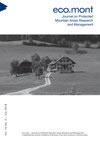Mapping spatial dimensions of Wilderness recreation outcomes: a study of overnight users
IF 0.8
4区 环境科学与生态学
Q4 BIODIVERSITY CONSERVATION
Eco Mont-Journal on Protected Mountain Areas Research
Pub Date : 2020-01-01
DOI:10.1553/eco.mont-13-1s31
引用次数: 3
Abstract
Grand Teton National Park (GRTE) is a popular mountain recreation destination which, like many National Park Service (NPS) units, has experienced a significant increase in visitation in recent years, with total visits increasing by 27% between 2014 and 2017 (NPS 2020). Particularly popular within GRTE is the String and Leigh Lakes (SLL) area, which is a favoured alpine destination for numerous day-use recreation activities and also an important starting point for backcountry and overnight recreational users within GRTE’s Recommended Wilderness. To better understand the visitor experience of overnight backcountry recreationists in the SLL area, data were collected using novel public participatory geographic information systems (PPGIS) during the summer of 2018. PPGIS data were used to identify the locations in which overnight recreationists experienced positive and negative recreation outcomes. Results indicate that they experience more positive outcomes within the Recommended Wilderness, away from high-density, trailhead-proximate areas outside the Recommended Wilderness. Findings also indicate that overnight users experience crowding and conflict more outside of the Recommended Wilderness than elsewhere on their backcountry trip. While this may seem intuitive, these are some of the first empirical results spatially contextualizing backcountry visitor outcomes in a popular national park. The findings thus provide managers with a visitor experience baseline that can be monitored and adaptively managed in the future.野外游憩结果的空间维度映射:一项过夜使用者的研究
大提顿国家公园(GRTE)是一个受欢迎的山地娱乐目的地,与许多国家公园管理局(NPS)单位一样,近年来游客人数大幅增加,2014年至2017年(NPS 2020)的总访问量增加了27%。在GRTE中特别受欢迎的是斯特林和利湖(SLL)地区,这是许多日间娱乐活动的首选高山目的地,也是GRTE推荐荒野中偏远地区和过夜娱乐用户的重要起点。为了更好地了解SLL地区野外过夜游憩者的游客体验,2018年夏季,使用新型公共参与式地理信息系统(PPGIS)收集了数据。使用PPGIS数据来确定过夜游憩者经历积极和消极游憩结果的地点。结果表明,他们在推荐的荒野中体验到更多的积极结果,远离推荐的荒野之外高密度的、接近小径的区域。研究结果还表明,过夜用户在“推荐荒野”以外的地方比在野外旅行的其他地方更容易遇到拥挤和冲突。虽然这可能看起来很直观,但这些是在一个受欢迎的国家公园中对偏远地区游客结果进行空间背景化的第一批实证结果。因此,研究结果为管理者提供了一个访客体验基线,可以在未来进行监控和自适应管理。
本文章由计算机程序翻译,如有差异,请以英文原文为准。
求助全文
约1分钟内获得全文
求助全文
来源期刊

Eco Mont-Journal on Protected Mountain Areas Research
BIODIVERSITY CONSERVATION-ECOLOGY
CiteScore
1.20
自引率
0.00%
发文量
1
审稿时长
>12 weeks
期刊介绍:
eco.mont offers a platform specifically for scientists and practitioners working in and on protected mountain areas in Europe and overseas.Target audiences of the journal are scientists from all related disciplines, managers of protected areas and an interested public including practitioners, visitors, teachers, etc.
 求助内容:
求助内容: 应助结果提醒方式:
应助结果提醒方式:


